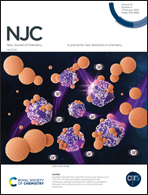Unusual isostructural Br/I substitution effect on the crystal structure and optical properties of hybrid halobismuthates†
Abstract
A series of hybrid halobismuthate solid solutions [4-Pi2C2]2[Bi2Br10-xIx] (4-PiC2 = 1,1′-(ethane-1,2-diyl)bis(4-methylpyridin-1-ium)) were obtained and structurally characterized. It was shown that upon Br/I substitution, the bromine atoms in the bridging positions of the anion were, first of all, replaced with iodine. In this case, significant and multidirectional deviation of the crystal lattice parameters of the solid solutions from Vegard's law was observed. The Bi⋯Bi distance in the mixed anions was greater than in the [Bi2Br10]4− or [Bi2I10]4−. The dependence of the optical band gap (Eg) on the composition of the anion also showed a significant deviation from Vegard's law. Moreover, a small substitution of iodine for bromine in the anion resulted in a significant decrease in the Eg value. A calculation of the simulated structures of the solid solution confirmed the relationship between the changes in the crystal lattice parameters upon Br/I substitution and the type of substituted halogen atom. It was shown that replacement of bridging bromine atoms with iodine atoms is a thermodynamically more favorable process than a similar substitution in terminal positions.



 Please wait while we load your content...
Please wait while we load your content...